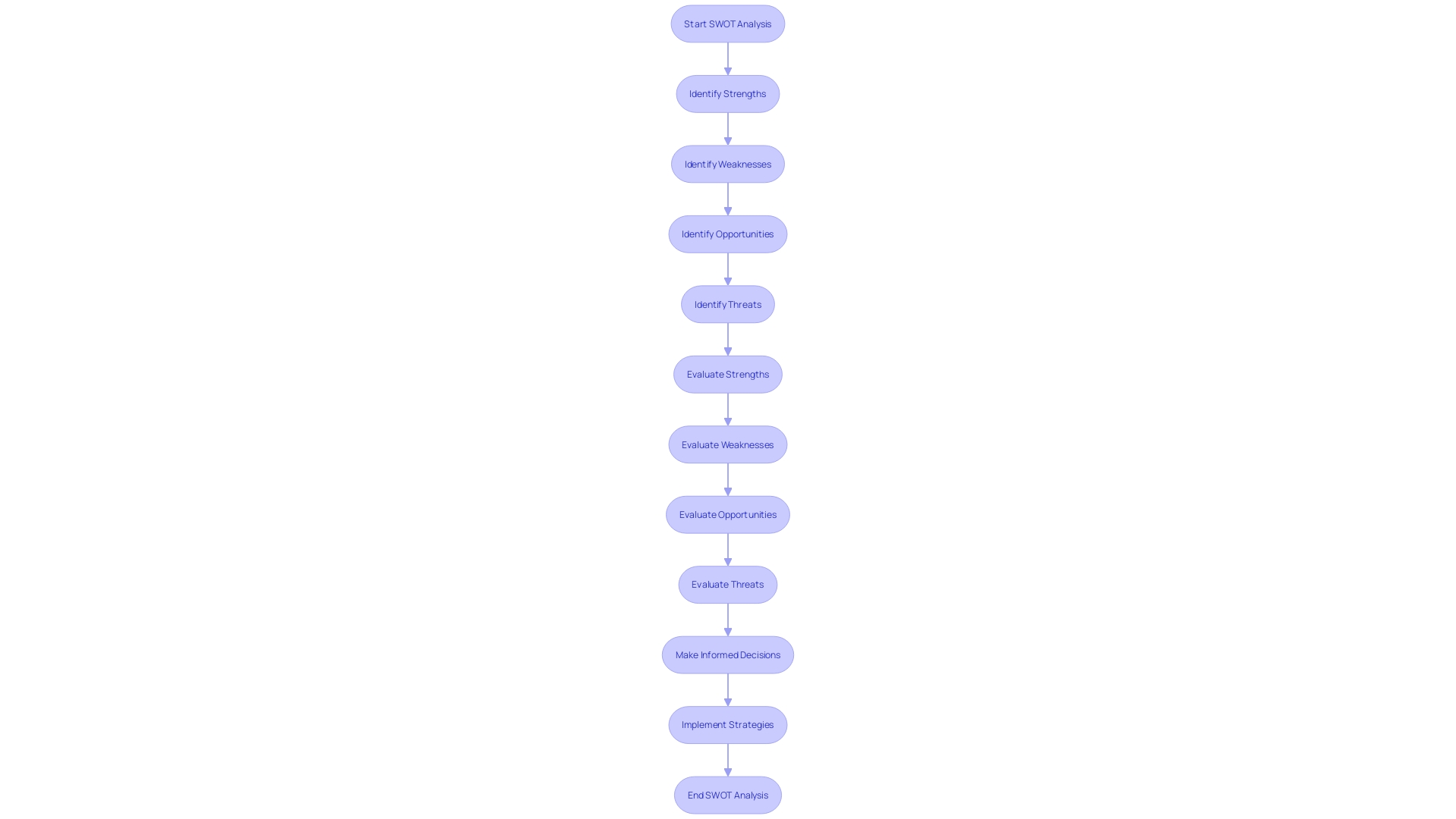Introduction
SWOT analysis is a powerful tool that helps businesses navigate the competitive landscape by analyzing their internal strengths and weaknesses, as well as external opportunities and threats. It provides a clear-eyed view of the organization's capabilities and vulnerabilities, enabling effective strategy development. In this article, we will explore the importance of SWOT analysis in business, a step-by-step guide to conducting it, and practical examples of how it can be applied in different industries.
Additionally, we will discuss how businesses can integrate SWOT analysis into their overall strategy and use it to create a content strategy that resonates with their target audience. By leveraging SWOT analysis, businesses can gain a comprehensive understanding of their position in the market and make informed decisions that drive growth and success.
What is a SWOT Analysis?
SWOT analysis serves as a compass for businesses navigating the competitive landscape. It dissects an organization's internal prowess and vulnerabilities alongside the external prospects and challenges. With its origins in the acronym for strengths, weaknesses, opportunities, and threats, this analytical framework guides companies of all sizes to introspect and strategize effectively.
By emphasizing a company's unique capabilities, such as a skilled workforce, robust financials, or cutting-edge technology, it underscores the elements that set the enterprise apart. Concurrently, it prompts a proactive stance towards external pressures, whether it's market volatility, rising costs, or competitive shifts. The assessment aids in framing strategies that leverage strengths to overcome weaknesses and seize opportunities while guarding against threats.
Notably, a SWOT analysis is not a one-time exercise but a continuous process aligning with the company's evolving objectives, such as those set for the fiscal year. For instance, in identifying threats, it's crucial to discern elements beyond the organization's control, such as economic downturns or labor shortages. A structured SWOT template can facilitate a clear-eyed view, laying the groundwork for actionable strategies.
This strategic tool's relevance is further evidenced by its application across diverse scenarios, from Siro's award-winning broadband services to innovative startups tackling social issues with technology.
Why Use a SWOT Analysis in Business?
A SWOT analysis, encompassing strengths, weaknesses, opportunities, and threats, serves as a cornerstone for strategic planning within organizations. It's a systematic method that uncovers vital internal and external elements influencing a company's operational framework. By evaluating what a business excels at and recognizing its shortcomings, this analysis illuminates areas for potential growth and aspects needing refinement.
Concurrently, it assesses the external landscape, pinpointing prospective opportunities ripe for seizing, and threats that demand strategic mitigation.
For example, strengths might be drawn from a company’s innovative technology, robust financial health, or a skilled workforce, each contributing to what makes the business distinctive in the marketplace. On the flip side, weaknesses could include areas where the organization falls short, such as outdated processes or limited market presence, which could hinder progress if left unaddressed.
Furthermore, opportunities often emerge from market trends or shifts in consumer behavior, while threats could stem from new regulations or competitive advancements. Staying attuned to these dynamics is paramount for businesses to navigate the market proactively. A practical application of SWOT analysis was demonstrated by Siro, a company recognized at the 2023 European Broadband Awards.
Their strategic use of the wholesale model, a strength identified in their SWOT analysis, contributed significantly to their success.
In project management, stakeholder analysis complements SWOT by identifying the influences and aspirations of those who have a stake in the business outcomes. This dual approach ensures that strategies are not only well-informed by the company’s position but also aligned with stakeholder interests, fostering a holistic view towards achieving business objectives.
Collectively, these analyses offer a structured pathway for businesses to critically examine their current state, envision their desired future, and strategically navigate the course to get there. Regularly revisiting and updating these assessments fosters agility, allowing companies to maintain their competitive edge and adapt to ever-evolving market conditions.
Step-by-Step Guide to Conducting a SWOT Analysis
Executing a SWOT analysis is a multi-step process that assists businesses in navigating their strategic landscape. To start, pinpoint the unique advantages your business has, recognizing what you excel at and the distinct edge over your competition. Next, candidly identify the areas where your business might not be performing optimally.
Following this, scout for potential growth avenues and expansion possibilities that could propel your business forward. It's equally important to be aware of external elements that could pose risks to your operations. Finally, synthesize this information to prioritize initiatives that can have the greatest positive impact and are realistically achievable.
For example, Siro leveraged their SWOT analysis to craft a wholesale model for their broadband rollout in Ireland, a strategy that earned them a top prize at the European Broadband Awards in 2023. Similarly, innovative companies are using SWOT analysis to venture into green fuel flights or develop apps to tackle social issues, proving the versatility of SWOT in guiding businesses towards groundbreaking initiatives.
By engaging with SWOT analysis, you can gain a comprehensive picture of your business, enabling you to make informed decisions that harness your strengths, shore up your weaknesses, seize opportunities, and mitigate threats. This process will not only help you understand your current market position but also shape the trajectory of your business for future success.

Example 1: SWOT Analysis for a Marketing Agency
A marketing agency's SWOT analysis is a strategic endeavor that identifies vital internal and external factors influencing its competitive position. The strengths of the agency might include its adept team, robust industry relationships, and a portfolio of successful campaigns. These attributes provide an edge in achieving business objectives and distinguishing the agency from competitors.
Weaknesses could manifest as gaps in expertise across various marketing platforms or constraints in resources, which need to be addressed to prevent them from impeding the agency's growth.
Opportunities present themselves in the form of rising demand for digital marketing services or untapped market niches. Seizing these chances can lead to business expansion and new client acquisition. On the flip side, threats such as fierce competition from established firms or fluctuating marketing regulations require vigilant risk management strategies.
This analysis is not merely a list but a dynamic template for action, helping the agency to leverage its strengths, shore up its weaknesses, exploit growth opportunities, and guard against potential threats. It reflects a clear understanding of the agency's operational environment, propelling it towards its annual goals and beyond. The insights gleaned from this SWOT analysis are instrumental in charting a course for the agency's future, ensuring it remains agile and responsive in an ever-evolving industry landscape.
Example 2: SWOT Analysis for an Ecommerce Business
-
Strengths: A user-friendly website, diverse product offerings, and robust online visibility give the ecommerce business a competitive edge. For instance, Spotify's seamless user interface and extensive music library have been fundamental to its growth, attracting over 500 million active users.
-
Weaknesses: Challenges such as inventory management inefficiencies can hinder the business's ability to meet customer demand effectively. As per recent insights, retailers acknowledge that on average, they have accurate inventory visibility only 70% of the time, highlighting the need for improved tracking systems.
-
Opportunities: Identifying emerging markets for specialized products or exploring international expansion can be game-changers. The growth of digital products in ecommerce exemplifies this, as platforms like Whop capitalize on the burgeoning demand for digital offerings.
-
Threats: Competition from established online retailers and potential logistical issues pose significant risks. Retailers must be vigilant about regulatory changes and competitive pressures that may disrupt their operations.
Through a SWOT analysis, the ecommerce business can map out strategies to capitalize on strengths, address weaknesses, leverage new opportunities, and guard against threats, with the ultimate goal of achieving sustainable growth and customer satisfaction.
How to Apply SWOT Analysis in Business Strategy
To effectively integrate SWOT analysis into business strategy, it's essential to align the analysis with the company's overarching goals. This ensures that the insights gained directly support the business's strategic objectives. From this alignment, actionable plans are developed that leverage the company’s unique strengths and address its weaknesses.
These plans should be designed to not only seize new opportunities but also to proactively mitigate potential threats.
Regular monitoring and adaptation are crucial as both the market and internal business conditions evolve. Businesses must remain agile, updating their SWOT analysis to reflect shifts in the competitive landscape or internal changes, such as technological advancements or shifts in consumer behavior. This continuous cycle of analysis, planning, and reassessment empowers businesses to maintain a dynamic strategy that is both responsive to immediate challenges and aligned with long-term success.
By leveraging the SWOT framework, businesses gain a comprehensive understanding of their internal capabilities and the external environment. This understanding is key to crafting strategies that not only address the current state of the business but also guide it towards future growth and stability. It's a tool that serves as a foundation for informed decision-making and strategic planning, ensuring that a company can navigate its industry's complexities with confidence.
Creating a Content Strategy Based on SWOT Analysis
Harnessing the power of SWOT analysis, businesses can fine-tune their content marketing strategies to stand out in an increasingly competitive digital landscape. Here's an actionable approach:
-
Capitalize on Strengths: Spotlight your brand's core expertise and knowledge through content themes that showcase your competitive edge, much like Mastercard emphasizes its global presence.
-
Tackle Weaknesses: Address gaps in your business knowledge or offerings by creating content that fills these voids, providing value and education to your audience.
-
Exploit Opportunities: With 72% of marketers using generative AI tools, it’s clear there’s a trend toward leveraging technology. Stay ahead by identifying and targeting emerging trends or untapped audience segments, and use insights from existing customer interactions to inform content that resonates.
-
Counteract Threats: In a market where differentiation is key and 57% of marketers struggle to create content that speaks to their audience, it’s crucial to produce content that preempts potential audience challenges and concerns, helping your brand to maintain relevance.
By integrating SWOT analysis into your content development process, you're not just creating content; you're strategically positioning your brand to connect with your audience and nurture business growth.

Conclusion
In conclusion, SWOT analysis is a powerful tool for businesses to navigate the competitive landscape and develop effective strategies. By analyzing internal strengths, weaknesses, external opportunities, and threats, companies gain a clear-eyed view of their capabilities and vulnerabilities.
SWOT analysis serves as a cornerstone for strategic planning, uncovering vital elements that influence a company's operational framework. It helps businesses identify areas for growth, refine operations, and mitigate threats. By staying attuned to market trends and consumer behavior, companies can proactively navigate the market.
Conducting a SWOT analysis involves several steps, including identifying advantages, recognizing areas for improvement, scouting growth opportunities, and being aware of external risks. By synthesizing this information, businesses can prioritize initiatives with a positive impact.
Practical examples demonstrate the versatility of SWOT analysis across industries, from marketing agencies leveraging strengths to ecommerce businesses capitalizing on opportunities.
To integrate SWOT analysis into business strategy, alignment with overarching goals is crucial. Regular monitoring and adaptation are key to maintaining a dynamic strategy that responds to challenges and aligns with long-term success.
By leveraging SWOT analysis, businesses gain a comprehensive understanding of their position in the market and make informed decisions. It serves as a foundation for strategic planning, ensuring companies navigate industry complexities with confidence.
Furthermore, SWOT analysis can be used to create a content strategy that resonates with the target audience. By capitalizing on strengths, addressing weaknesses, exploiting opportunities, and countering threats, companies can strategically position their brand for growth.
In conclusion, SWOT analysis is an essential tool for businesses to gain a competitive edge, make informed decisions, and drive growth. It provides a comprehensive view of the business landscape and enables companies to navigate challenges and seize opportunities effectively.




